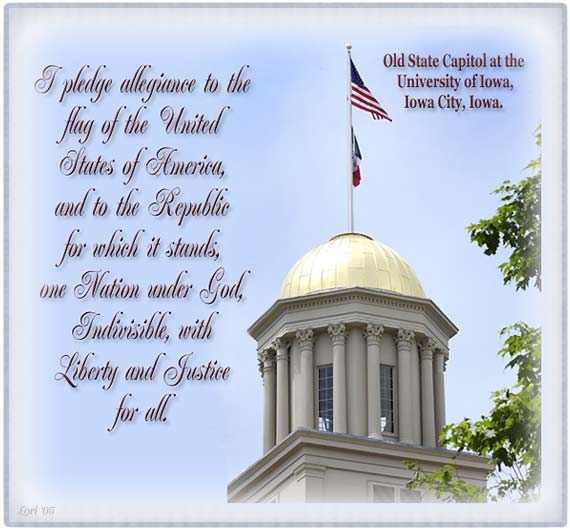
The Hawkeye State
"Our Liberties We Prize
and Our Rights We Will Maintain"
A Brief History of
Our 29th State
The first white men who saw Iowa were the French Jesuit Father Marquette and Louis Joliet, who on the 17th day of June, 1673, coming down the mouth of the Wisconsin River, discovered the Mississippi and faced the picturesque bluffs of the Iowa shore. The first landing on Iowa territory recorded by Father Marquette in his journal was near Montrose, in Lee County, where he had a peaceful and memorable meeting with the natives. One hundred and fifteen years passed away from the time of Father Marquette's discovery until the first white settlement was made within the limits of the state. In 1788 Julien Dubuque, a French Canadian trader, obtained from the Indians a grant of land, in which to mine for lead; it extended seven leagues along the west bank of the Mississippi and was three leagues in width, including the territory on which now stands the city of Dubuque. This grant was afterwards confirmed by Baron de Carondelet, the Spanish governor of the province of Louisiana, and the strip of land became known as the Mines of Spain. Here Dubuque, with ten other Canadians, and aided by the Indians, operated the mines until his death in 1810, when the whites were driven out. Dubuque was buried on the top of an isolated bluff just below the present limits of the city of Dubuque, and a large cross marked his grave for many years. This became a well-known landmark to river men on the upper Mississippi, and is mentioned in books of travel. In 1832, in the territory east of the Mississippi, occurred the war with the Indians known as the Black Hawk War. This resulted in a treaty, made in the same year, by which the Indians relinquished that part of Iowa known as the Black Hawk Purchase, containing six million acres of land, lying immediately west of the Mississippi River, about ninety miles in width, and north of the Missouri State line. Although this was not the first concession of territory in Iowa by the Indians, it was the first which opened any portion of the land for settlement by the whites. Settlements were made in 1833 at Dubuque and at other points near the Mississippi River. Within ten years the title to practically all of the state was secured by treaties with the Indians. Attracted by glowing accounts of the richness of the soil, immigrants came pouring in from the New England states, New York, Illinois, Ohio, Kentucky, North Carolina, Missouri, and other states.
In 1834 that part of the Louisiana Purchase now included in the State of Iowa was made a part of the Territory of Michigan; in 1836 it was attached to, and made a part of, the new Territory of Wisconsin, and in 1838 was established separately as the Territory of Iowa. On 28 December, 1846, it was admitted to the Union as the twenty-ninth State, being the fourth state created out of the Louisiana Purchase. In 1854 the first railroad was built from Davenport west, and railroad-building then extended rapidly. In the same year was passed a law, prohibiting the sale of intoxicating liquors which, with some changes, is still on the statute books. In 1857 the state adopted a revised Constitution which, with a few amendments, is still the law. The progress of the state was checked by the Civil War, at the close of which, however, immigration recommenced, and population and wealth increased. Although the population in 1860 was less than 700,000, the state furnished, during the Civil War, 75,519 volunteers.
Iowa's Capitol
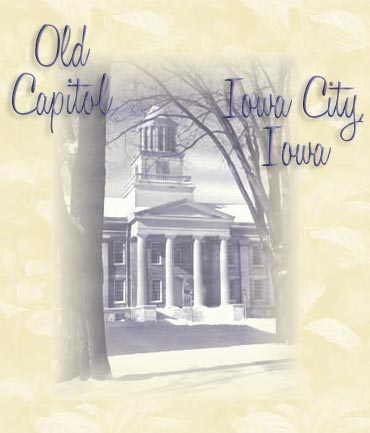
During the over 150 years that Old Capitol has served Iowa as a seat of government and education, it has become a symbol of pride and excellence for The University of Iowa, Iowa City and the state. When Old Capitol's cornerstone was laid on Independence Day in 1840, Iowa City became the first "permanent" capital of Iowa, where the last four Iowa territorial legislatures met. In Old Capitol, Iowa made the transition to statehood. Here, the first governor was inaugurated, the first six Iowa general assemblies met, and the state's constitution--still the fundamental law of the state--was drafted. When the state government moved to Des Moines in 1857, Old Capitol was deeded to The University of Iowa and became the first building owned by the University.
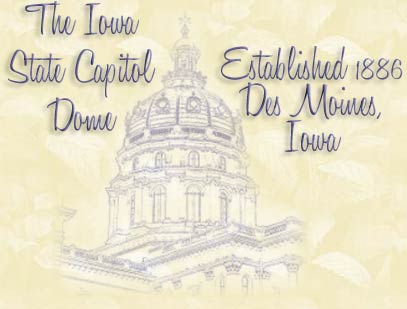
The Iowa State Capitol in Des Moines, signifies the prodigious spirit of Iowa. Built between 1871 and 1886, this magnificent building represents, both inside and out, one of the nation's finest examples of 19th century architecture. Inside, the building features an array of majesty including many different types and colors of marble, works of art, fixtures and carvings in both wood and stone. One of the most commanding features of the building is the towering dome. The dome, constructed of steel and brick, is externally gilded with 23-karat gold leaf. A belvedere on top of the large dome features a golden lantern at the top. In addition, four smaller golden lanterns are each attached to copper-covered domes at every corner of the building. These four domes are decorated with vertical lines of intermittent gold, giving each a braided look. The state capitol is truly an impressive Iowa landmark. Each year the state capitol is visited not only by Iowans, but by people from all over the world. The capitol's golden dome can be seen for miles, symbolizing representative government for the citizens of the state.
Take a Tour of Iowa's Capitol Here

So, what is a "Caucus",
and why should we care about Iowa's?
- What's a political caucus?
- A caucus is a political meeting at the local precinct level during which delegates are selected to represent the sponsoring party at the county convention. County convention delegates, in turn, select delegates to the district, state and national conventions. The Democratic and Republican National Conventions then select their parties' nominees for President and Vice President, so the local caucus is the first step in nominating Presidential and Vice Presidential candidates for office.
- Why are Iowa's caucuses so important?
- Iowa's caucuses are important because they are the first to be held in the nation during each Presidential election cycle. They are the candidates' first opportunity to gauge their level of approval or popularity among voters.

- Ripley's Believe It or Not has dubbed Burlington's Snake Alley the most crooked street in the world.
- Dubuque is the state's oldest city.
- Spirit Lake is the largest glacier-made lake in the state.
- Imes Bridge is the oldest of Madison County's six bridges.
- Iowa's longest and highest bridge crosses Lake Red Rock.
- Elk Horn in the largest Danish settlement in the United States.
- At 16 miles, East Okoboji is the longest natural lake in the state.
- Kalona is the largest Amish community west of the Mississippi River.
- The Holliwell Bridge is the longest bridge in Madison County.
- Francis Drake was 66 years old at his inauguration and Iowa's oldest governor.
- Quaker Oats, in Cedar Rapids, is the largest cereal company in the world.
- The Saint Francis Xavier Basilica in Dyersville is the only basilica in the United States situated outside a major metropolitan area.
- Cornell College is the only school in the nation to have its entire campus listed on the National Register of Historic Places.
- A bronze life-sized sculpture of a Norwegian immigrant family (circa 1860) is located on a six acre restored prairie site located at the east entry to Lake Mills on Highway 105.
- Iowa's only operating antique carousel is located in the city of Story City.
- Iowa's only fire tower is situated in Yellow River State Forest.
- Herbert Hoover, a West Branch native, was the 31st president of the United States and the first one born west of the Mississippi.
- Mamie Doud Eisenhower's birthplace is located in Boone and includes a restored frame house, complete with summer kitchen and original furniture from the family.
- Van Meter is the hometown of baseball's Bob Feller, an Iowa farm boy who went on to greatness with the Cleveland Indians during the Golden Age of baseball.
- Born Donnabelle Mullenger in Denison, Oscar Award-winning actress, Donna Reed, started her career at the young age of 16.
- Glenn Miller, noted trombonist and orchestra leader, was born in Clarinda located in Southwest Iowa.
- The town of Fort Atkinson was the site of the only fort ever built by the U.S. government to protect one Indian tribe from another.
- Iowa is the only state whose east and west borders are 100% formed by water.
Missouri and Mississippi rivers.
- The highest double track railroad bridge in the world, the Kate Shelley Bridge, is located at Boone.
- Iowa is the only state name that starts with two vowels.
- The famous actor John Wayne was born in Winterset on May 26, 1907.
- Iowa State University is the oldest land grant college in the U.S.A.
- Decorah hosts Nordic Fest a three-day celebration of Decorah's Scandinavian heritage.
- The National Balloon Museum in Indianola chronicles more than 200 years of ballooning history.

|
|
|

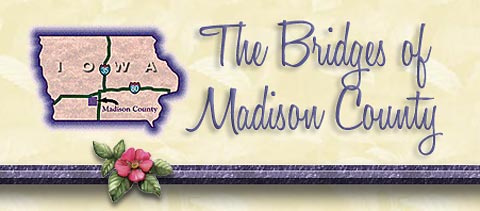
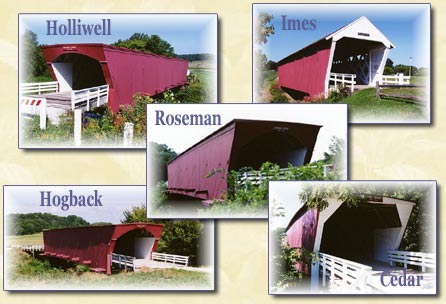
Winterset, Iowa, has never ranked with Acapulco and Aruba on any list of top tourist destinations.
''We're the breadbasket of the U.S. here,'' says Chamber of Commerce Director Stephanie Fuller. ''Most people relate to us as (having) cornfields, pigs and cows.''
But things changed in the farming town of 4,200 people - where the biggest claim to fame used to be John Wayne's birthplace - thanks to author Robert James Waller, actor/director Clint Eastwood, and a romantic little tale called ''The Bridges of Madison County.''
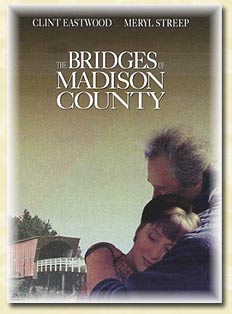
Before ''Bridges,'' published in 1992 and made into a movie by director Eastwood in 1995, Fuller expected about 10 visitors a week in her office, most of them there to see the first home of ''The Duke.''
In 1995, Fuller welcomed more than 30,000 people to the Madison County seat, sometimes as many as 500 in one day. The film created an instant cottage industry in the town. The covered bridges, which Eastwood's character is sent to photograph in the film, the farmhouse where actress Meryl Streep's character lived, and anywhere else remotely related to the film became instant tourist attractions.
''Iowa was not known as a tourism state,'' she said. ''When tourists got here, they were just amazed there are things to see in Iowa.'' ........By Doug Gross, Savannah Morning News

More information on
the bridges of Madison County.
|
|
|


Buffaloaf
2 lbs. ground Bison
1 1/2 pkg. soda crackers, finely chopped
1 egg
1/2 C milk
1/2 medium onion, chopped
1/2 medium green pepper, chopped
2 tsp. Worcestershire sauce
salt, Pepper, Garlic salt
Mix all the ingredients together and form into loaf. Bake at 275 - 300 F for approximately 1 hour. Serve on a platter with desired garnishes.

So, what's so special about Iowa?
Well, I can think of a couple things........
- Iowa rates SIXTH on the list of "Most Livable States, 2005"!
- The internationally-acclaimed Iowa State Fair - "America's Favorite Fair" - annually attracts more than a million fun-lovers from around the world. Midwest Living magazine recently named the event one of the "Top 30 Things Every Midwesterner Should Experience." Last year's record-breaking Fair was named the #2 choice for summer fun in America by USA Weekend. This year's event promises 11 action-packed days of favorite foods, entertainment, competition and traditions August 11-21 in Des Moines.
I hope that our Iowa FReepers will stop by and tell us many more reasons why Iowa is a great place to call home!

And, last but not least, two thumbs up for the
University of Iowa's Fine athletic program!


The following websites provided information
and graphics for this presentation...
Iowa Fast Facts
The Bridges of Madison County
Decision Iowa
History of Old Capitol

|
|
|
|
|
|
|


